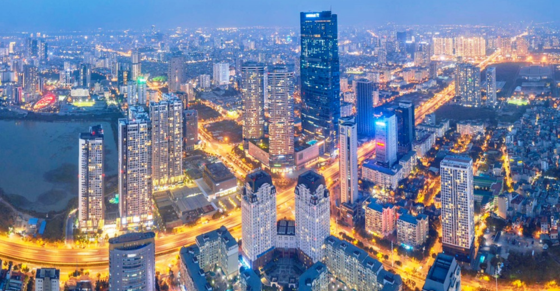Planning for construction and development of the Capital of Vietnam from January 01, 2025
The content of the article presents the planning and development of the Capital based on the Law on Capital 2024, recently passed by the National Assembly of Vietnam on June 28, 2024.

Planning for construction and development of the Capital of Vietnam from January 01, 2025 (Image from the Internet)
On June 28, 2024, the National Assembly off Vietnam passed the Capital Law 2024.
Planning for construction and development of the Capital of Vietnam from January 01, 2025
Article 17 of the Capital Law 2024 stipulates the Planning for construction and development of the Capital of Vietnam as follows:
- The construction and development of the Capital must be carried out according to the Capital Planning, General Capital Planning.
The Capital Planning and General Capital Planning must ensure the construction of an ancient, civilized, modern, and sustainable Capital, with a clean living environment, water security with the Red River as the green axis, central landscape, and harmonized urban development on both sides of the river; ensuring national defense, security, and connectivity of the Capital’s technical and social infrastructure with localities involved in regional development and linkage with the Capital and the entire country.
- Concentrate resources, prioritize the implementation of the Red River and Duong River sub-regional planning in line with the Capital Planning and General Capital Planning.
Allow the construction of new dikes according to the flood prevention planning of the river dike line, dike planning, and other related planning to effectively utilize the land fund.
In the riverine area, certain existing residential areas are allowed to persist, and new constructions, residential buildings are permitted at a suitable ratio according to the flood prevention planning of the river dike line and other related planning; the remaining riverine and islet areas are permitted to build public space facilities and public service facilities without raising the riverine, islet area to ensure it does not obstruct the flow.
- The City People's Committee decides on adjusting the environmental zoning in the Capital Planning, local adjustments to the general urban planning, general planning of functional areas, and specialized technical infrastructure planning of the City that have been approved by the Prime Minister and reports the implementation results to the Prime Minister.
The City People's Council stipulates the detailed procedures for adjusting environmental zoning, local adjustments to the planning stipulated in Clause 3, Article 17 of the Capital Law 2024.
- For areas with approved general or subdivision planning, or district construction planning according to the planning law, construction law, and urban planning law, it is not necessary to establish district-level land use planning but should base on the general or subdivision planning, district construction planning, and the allotted land use indicators from the General Capital Planning and local land use indicators to make the annual district-level land use plan.
Measures to Ensure the Planning for construction and development of the Capital of Vietnam
Article 18 of the Capital Law 2024 stipulates the measures to ensure the Planning for construction and development of the Capital of Vietnam as follows:
- In the historical inner city, the land area of existing hospitals shall not be expanded; no new industrial zones, industrial clusters, industrial production facilities, higher education institutions, or vocational education institutions shall be established or expanded.
Higher education institutions, vocational education institutions that do not have main offices or training locations in the historical inner city before the effective date of the Capital Law 2024 shall not establish training locations within the historical inner city.
- Industrial production facilities, medical facilities, higher education institutions, vocational education institutions, and offices of the agencies, units in the central urban area that do not fit with the General Capital Planning must be relocated.
- The authority to decide on the relocation of the facilities and offices stipulated in Clause 2, Article 18 of the Capital Law 2024 is regulated as follows:
+ The Prime Minister decides on the list, measures, and schedule of relocating industrial production facilities, medical facilities, higher education institutions, vocational education institutions, and offices of agencies, units under the management of central agencies, organizations;
+ The City People's Council decides on the list, measures, and schedule of relocating the facilities, offices not stipulated in point a, Clause 3, Article 18 of the Capital Law 2024.
- The City People's Committee is responsible for allocating suitable land according to the planning to relocate the agencies, units, and facilities that need to be relocated according to Clause 3, Article 18 of the Capital Law 2024 to build new facilities and offices if necessary.
- The land fund after the relocation stipulated in Clause 2, Article 18 of the Capital Law 2024 shall be handed over to the City People's Committee for management and use according to the following regulations:
+ In the historical inner city area, public spaces shall be constructed, increasing the proportion of green land for public use, preserving and promoting cultural values, developing tourism, without allocating residential and accommodation functions;
+ In other areas of the central urban area, priority shall be given to constructing public works and social welfare facilities, ensuring compliance with social infrastructure and technical infrastructure standards based on urban classification.
- When investing in new road and urban railway tracts or expanding existing road tracts according to the planning in the City, the planning authority must determine the location, boundary, and area of land acquisition in the proximity of the road, urban railway to carry out urban renovation, on-site resettlement, housing development, commerce, and services.
The City People's Committee is responsible for reporting to the City People's Council for consideration and decision on the location, boundary, and area of land acquisition in the proximity of the road, urban railway to carry out urban renovation, on-site resettlement, housing development, commerce, and services before the detailed planning is approved.
When implementing road and urban railway development projects according to approved planning, the competent authorities of the City simultaneously organize the land acquisition of the surrounding areas for use according to the planning. In this case, land acquisition is applied as if it were within the same road and urban railway development project.
- The City People's Committee approves investment projects for building structures in riverine and islet areas of the rivers with dikes in the City according to the Capital Planning, General Capital Planning, and other related planning.
The City People's Council stipulates detailed procedures for investment in building structures on riverine and islet areas.
More details can be found in Capital Law 2024 which comes into force in Vietnam from January 01, 2025.
- Number of deputy directors of departments in Vietnam in accordance with Decree 45/2025/ND-CP
- Cases ineligible for pardon in Vietnam in 2025
- Decree 50/2025 amending Decree 151/2017 on the management of public assets in Vietnam
- Circular 07/2025 amending Circular 02/2022 on the Law on Environmental Protection in Vietnam
- Adjustment to the organizational structure of the Ministry of Health of Vietnam: Certain agencies are no longer listed in the organizational structure
- Vietnam aims to welcome 22-23 million international tourists in Vietnam in 2025
-

- Number of deputy directors of departments in Vietnam ...
- 15:04, 05/03/2025
-

- Cases ineligible for pardon in Vietnam in 2025
- 14:43, 05/03/2025
-

- Decree 50/2025 amending Decree 151/2017 on the ...
- 12:00, 05/03/2025
-

- Circular 07/2025 amending Circular 02/2022 on ...
- 11:30, 05/03/2025
-

- Adjustment to the organizational structure of ...
- 10:34, 05/03/2025
-

- Notable new policies of Vietnam effective as of ...
- 16:26, 11/04/2025
-
.Medium.png)
- Notable documents of Vietnam in the previous week ...
- 16:21, 11/04/2025
-
.Medium.png)
- Notable documents of Vietnam in the previous week ...
- 16:11, 02/04/2025
-
.Medium.png)
- Notable new policies of Vietnam to be effective ...
- 16:04, 02/04/2025
-
.Medium.png)
- Notable new policies of Vietnam effective from ...
- 14:51, 21/03/2025

 Article table of contents
Article table of contents
